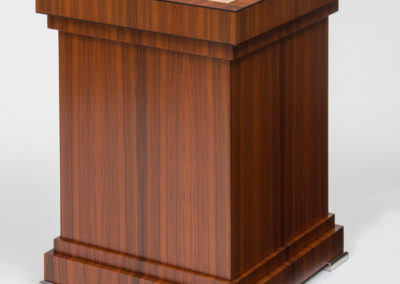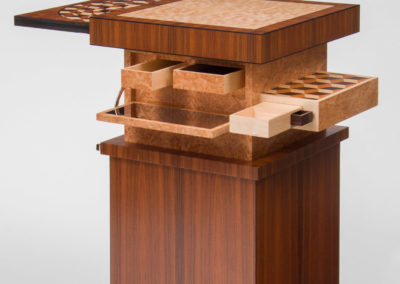Automaton Mechanical Table
Size:
20″ wide by 20″ deep by 34″ high
Materials:
Pau Ferro, Maple Burl, Ebony, Maple, Stainless Steel, and various marquetry woods
Description:
My latest work exploring mechanical furniture and hidden compartments is some of the most expensive furniture I build due to the highly complex design and fabrication process. Depending on the complexity of the internal mechanisms and the variety of hidden details incorporated into the design the cost can easily exceed $35,000 for one of these highly unique pieces.
This Art Deco Table is a mechanical table that has at its core mechanical functionality inspired by the work of Abraham and David Roentgen, who specialized in highly complex mechanical furniture over a quarter millennia ago (1760-1790) for clientele that included Marie Antoinette, Empress Catherine II, and King Frederick William II.
When examined closely, the table reveals a series of hidden elements. Starting inside the top section is a slide out puzzle with five concentric rotating parquetry panels. When aligned correctly, the panels reveal a pattern of impeccably executed Louis Cube parquetry. Next, a slight press on the table top results in the entire central column dramatically rising up, activating additional elements, including a hinged tray that drops down to reveal a polished stainless steel insert and several of the first hidden drawers hidden throughout the table.
Simultaneously sliding out from another side of the column a large box topped with additional Louis Cubes—a recurring theme—is exposed. While this concludes the autonomic opening elements of the table, the user is left to discover many additional hidden elements.
Close inspection of the central column reveals a concealed button, which activates another secret drawer on the opposite side of the column. An opening at the front of the drawer is what is initially revealed, and then the entire drawer can be pulled out to discover yet another secret compartment on the bottom with a sliding lid.
Additional examination of the outer surface of the table structure includes what appears to be a button, but when depressed, releases an ebony bar that serves as a magnetic key, which opens the two drawers that were revealed when the stainless tray dropped during the autonomic opening of the table.
Each drawer reveals an additional design detail—a segmented section for storing collectible writing instruments, and a third area of Louis Cubes which can be seen reflected below in the polished stainless steel tray insert. There are also two additional hidden drawers in the large box section on the adjoining side of the table— one releasing from the other, each activated with the magnetic key.
The YouTube video of this piece was created by my website designer Chad Thompson of Monkey C Media, thanks Chad.
This table also won the Grand Prize in the 2016 Craftsman’s Challenge contest sponsored by Veneer Tech.





